¶ Introduction
As we all know, the engine as one of the core parts of an aircraft is very expensive. Roughly speaking, an engine can cost anything from 1 to 35 million dollars. Therefore, how to use and maintain the engine scientifically and how to increase the profits effectively become very important for all operators. However, only innovating the technology and renewing the equipment are far from enough.The scientific engine technical management will increase the profits and reduce costs. And then reduced takeoff thrust (RTOT) comes to the scene. The RTOT procedure has been developed in order to improve engine reliability and to conserve engine life. Clearly it can be used only when full takeoff thrust is not required to meet the various performance requirements on the takeoff and initial climb out.
¶ Rationale
Operational manual limitations, the runway specific criteria of length, altitude and obstacles factored against the actual aircraft weight and existing environmental conditions allow the calculation of the actual amount of thrust necessary to meet Regulatory requirements for takeoff. In a significant percentage of cases, the required thrust is less than that which the engines are capable of producing.
The primary advantage to a RTOT is cost savings through increased engine life and reduced overhaul costs.
A takeoff can be limited by many considerations. Significant in terms of RTOT:
- Takeoff and stopping distances (increases with RTOT)
- Engine out climb capability (reduces with RTOT)
- Engine out obstacle clearance (reduces with RTOT).
Very often aircraft's actual takeoff weight is less than certified
maximum takeoff weight due to short flight, number of passengers, weight of luggage and cargos or operator's fuel policy. So, where the proposed takeoff weight is such that none of these considerations is limiting, then the takeoff thrust may be reduced, within reason, until one of the considerations becomes limiting.
Note that airplanes approved for RTOT have flight manual appendices containing all the information necessary.
¶ Regulatory
Usually reduced thrust operational procedures should be certified and approved. These are the typical typical steps:
- Aircraft flight manual provides certification and authorization;
- Operator established operating procedures;
- Local regulatory authority (Civil Aviation Authority aka CAA) grants final approval.
Main regulatory references are:
- FAA Advisory circular AC 25-13
- JAA AMJ 25-13
¶ Benefits of using RTOT
Using reduced thrust lowers the jet engine's internal operating pressure and temperature. The primary advantage to a RTOT is cost savings through increased engine life and reduced overhaul costs. Secondary advantages include fuel savings and that, under certain circumstances, it may be possible to increase the maximum takeoff weight for a specific runway by using a reduced thrust profile. Therefore, the main benefits are:
- Reduced stress and wear on the engine;
- Reduced cost on parts and mainenance;
- Increased engine life;
- Increased reliability, thus improving operating safety and efficency.
Reduced takeoff thrust may increase the airplane-to-ground noise level as a result of the lower flight path.
¶ Methodology
There are two methods of achieving an accurately controlled reduction in engine thrust: assumed temperature and derate.\
Dependant upon the engine manufacturer, one or both of these thrust reduction methods may be available to the operator. When both possibilities are available, the engine design may allow that both derate and assumed temperature can be used simultaneously or, conversely, the two methods of reducing engine thrust may be mutually exclusive.
¶ Assumed temperature
Sometimes referred to as Flexible temperature or FLEX
Assumed temperature method is the setting of takeoff thrust by entering in the FMC a temperature higher than the actual outside air temperature (OAT).
The principal limitations of a jet engine are the maximum internal pressure that the casing can withstand and the maximum allowable operating temperature. The FADEC (or any other similar engine management system) will be programmed to flat rate the engine at a thrust corresponding to a safe internal engine pressure. The FADEC compensates for varying OAT and pressure altitude by adjusting the fuel flow and limiting the rotational speed of the engine. So, if the amount of thrust that the engine can generate under given environmental conditions exceeds that required for takeoff, the FADEC can be "instructed" to reduce the amount of thrust to be produced by the engine.
At outside air temperatures above the flat rated temperature, there is a specific thrust value (variable by pressure altitude) for each temperature. If the thrust requirement for the takeoff is known, the associated temperature at which this thrust would be produced can be extracted from the applicable charts.
This is called assumed temperature thrust. We assume that the OAT is higher then it really is. It allows us to use appropriate thrust setting, enough for takeoff in existing conditions.
Main limitations for the assumed temperature method are:
- Maximum of 25% thrust reduction is allowed per regulations;
- Prohibited on slippery or contaminated runways;
- Prohibited for dispatch with some systems inop.
¶ Derate
A derate selection electronically reduces the rated thrust of the engine to either one or more prespecified values or by a selectable percentage of the normal flat rated thrust. As this new thrust limit cannot be exceeded during the takeoff phase, critical speeds such as VMCG and VMCA change from those associated with full rated thrust.
Consequently the AOM (Aircraft Operating Manual) must include performance data for all permissible derate selections.
¶ Practical example
There are two common ways to calculate optimal reduced thrust for takeoff - paper-based and computerized.
1. Paper-based systems. It requires:
- takeoff analysis (maximum takeoff weight table)
- takeoff speed charts (QRH).
2. Computerized systems. It requires:
- Boeing laptop tool (BLT), or
- electronic flight bag (EFB), or
- any other approved and certified tool, like Boeing OPT, Foreflight etc.
Let's get through a practical exercise and calculate reduced thrust (assumed temperature method), using Boeing official manuals.
Conditions: Boeing 737-800 with 26k rating, runway length 3600 m, airfield elevation 2000 ft. No slope, no obstacles.
OAT 14°C, actual takeoff weight 68700 kg. Headwind 10 kt, runway is dry, takeoff flaps 5.
First, let's determine maximum takeoff weight in current conditions.
Go to FCOM - Performace Dispatch - Takeoff. Make sure you are using the correct section for your engine rating and certified agency (CFM56-7B26 JAA in our case). Start with runway length correction for current headwind:
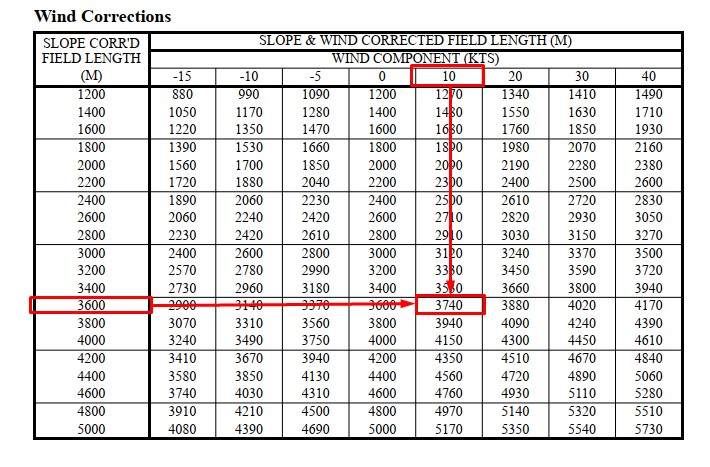
Then go to FCOM - Performace Dispatch Takeoff Field & Climb Limit Weights -- Dry Runway for 2000 ft elevation. Use corrected runway length of 3740 m and OAT of 14oC:
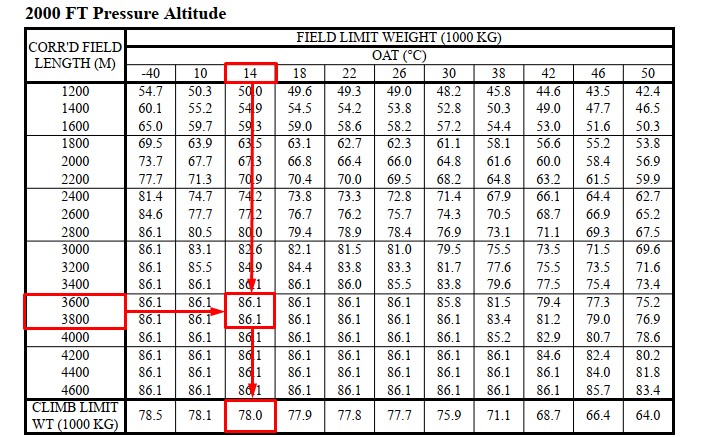
Note the most limiting weight is climb limit weight (78000 kg). Actual takeoff weight is 68700 kg, which is lower than the limit. So, we are able to reduce takeoff thrust.
Move to FCOM - Performance Inflight - Assumed Temperature Reduced Thrust. Use OAT and airfield elevation to find out maximum assumed temperature of 64oC:
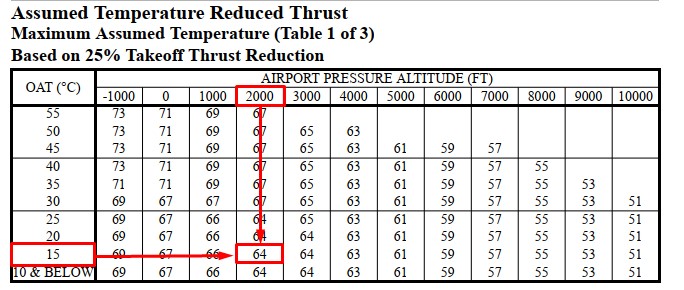
Go back to FCOM - Performace Dispatch Takeoff Field & Climb Limit Weights and use actual takeoff weight as the most limiting weight to find out related temperature:
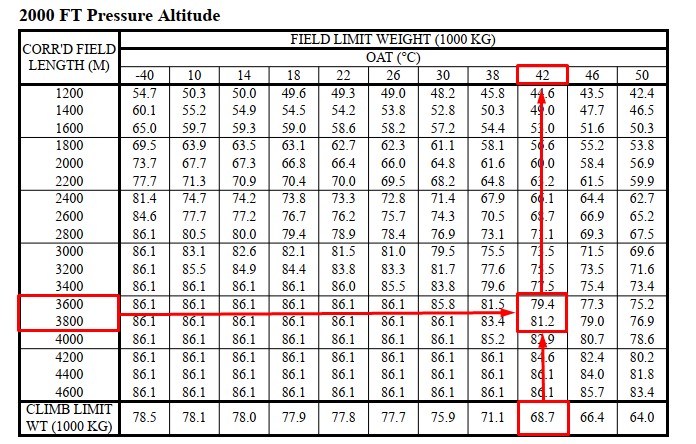
So, the temperature is 42oC. It's lower than the maximum allowed assumed temperature (remember, it was 64oC), because our actual takeoff weight is lower than maximum certified.
The next step is to put the assumed temperature of 42oC into the CDU (SEL TEMP block) and the FMC will calculate the N1 limit. In case of missing FMC or failed CDU we can use FCOM to calculate it.
Use table 2 of the Assumed Temperature Reduced Thrust section:
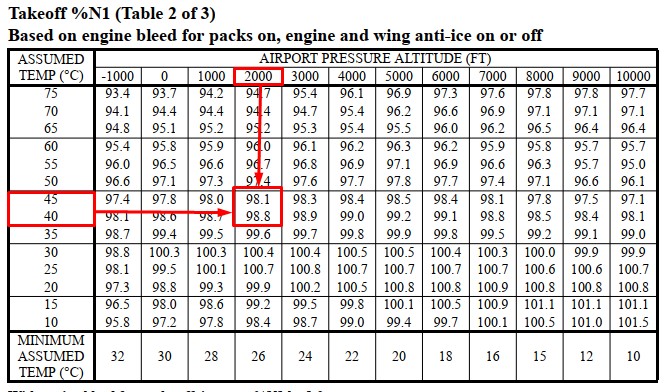
We got 98.5% N1. The next step is to correct N1 for the difference between maximum and actual assumed temperature. Use table 3 of the same section:
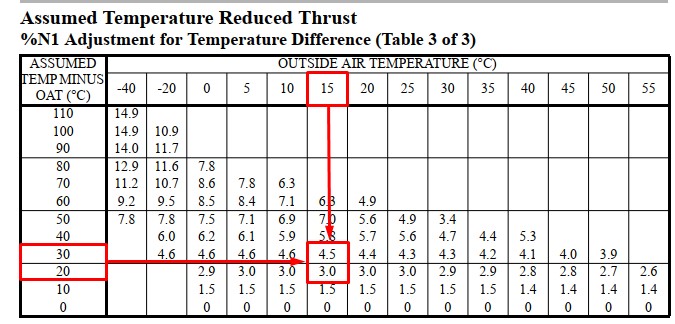
So, N1 adjustment is 4.5%. Reducing maximum N1: 98.5 - 4.5 = 94% N1.
Here is our final result: assumed temperature is 42oC, N1 is 94%.
Note that the method works with no obstacles. Otherwise you need to calculate obstacle limit weight.
- None
- B737 FCOM and QRH
- Reduced Thrust - Boeing official presentation by Dennis Ting, 2002.
- Skybrary.aero
- VID 531824 - Creation
- VID 496402 - Wiki.js integration